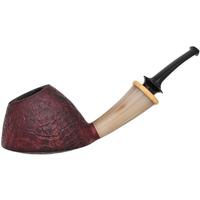Most native English speakers know subconsciously (and few native English speakers know consciously) that adjectives are ordered as follows:
(1) Opinion
(2) Size
(3/4) Age or Shape (these are interchangeable, on a case by case basis)
(5) Color
(6) Origin
(7) Material
(8) Purpose
This isn't an original observation -- it's a well established norm, and you can read about it elsewhere.
You may not give it any thought, but you'd sense that something were out of whack if I referred to an "American blue old big truck," or to a "wheat golden expansive lovely field."
Just how this norm applies to pipe descriptions is not always obvious, though. For instance:
- Where does brand fit into this?
- Should we lump "finish" with "color"?
- How do we classify such meerschaum descriptions as "lion" or "lattice"?
- And does "shape" here apply to "pipe shape" (billiard, freehand, bulldog) or to bend (straight, quarter bent, half bent) or to length (nose warmer, long-shanked)?
Or for that matter, to whether or not the pipe is a "sitter"?
Or to such additional proportions as "chubby" or "angular"?
We shouldn't equivocate between "shape" and "shape," here -- in pipe culture, we use "billiard" substantively, in a way which is parallel to "pipe," not in a way which is parallel to "oval."
Neither should we just assume that a pipe description follows the English norm: it may turn out that pipe culture has unwittingly cultivated its own norm. And in fact this seems to be the case: for example, it seems that we commonly mention origin (country, brand, and line) after opinion, size, and age, but before further physical description. So, we need not so much a proposal as an observation.
Towards that end, I
think that I observe the following order of description in pipe culture:
- Opinion (e.g. nice, masculine)
- Size (e.g. large, little)
- Age (e.g. old, antique)
- Country (e.g. Danish, French)
- Brand (e.g. Stanwell, Ropp)
- Line (e.g. Golden, Vintage)
- Color (e.g. dark, red)
- Finish (e.g. sandblast, rusticated)
- Proportional Comment (e.g. chubby, angular)
- Length (e.g. nose-warmer, long-shanked)
- Bend (e.g. straight, quarter-bent)
- Meerschaum Design (e.g. lion, lattice)
- Shape (e.g. billiard, freehand)
- Secondary Material (e.g. meerschaum-lined)
- Primary Material (e.g. briar, meerschaum)
- Mount (e.g. military mount, spigot)
- Final Substantive (e.g. sitter, churchwarden)
NOTE:
The stem description should not be included in the above, but rather annexed to the end with a prepositional phrase, e.g. "with bakelite saddle stem." You'll notice that within that phrase, material and shape seem to be out of order, but this is only because we use a term like "saddle stem" substantively rather than adjectivaly in pipe culture.
NOTE:
Obviously, some of these categories are not applicable to some pipes. And even when many categories are applicable, no single pipe description could include all of these parts without sounding extremely awkward. This list is not meant to enumerate everything which should be included in any given pipe description. Rather, it's meant to order whichever parts are included, in any given case.












